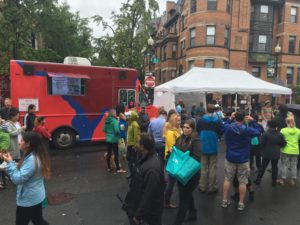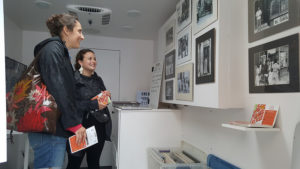By Olivia Williams, PhD student at American University in the School of Communication
The second weekend of September 2018 saw a throng of people excitedly visiting the Adams Morgan Day event in that culturally diverse and artistic area of Washington D.C. Even the rain couldn’t dampen spirits as families, couples, friends and visitors to the city, wandered from stall to stall and booth to booth.

Musicians, artists, poets, chefs, jewelers, dancers, creators of all varieties lined the main street, and there was a celebratory atmosphere which epitomized the well-known creative ‘AdMo’ community. Our Humanities Truck caught the attention of many passersby and the promise of a walk down AdMo memory lane inside encouraged visitors to step inside! The Humanities Truck is one node of a larger project funded by the Smithsonian: a storytelling system that brings the exhibit ‘A Right to the City’ back onto the streets, as well as recruiting voices from within the community. (See our vision.)

The project combines the digital and the physical to connect stories across places and people. In documenting the project and studying its impact, I began by filming voxpops and interviews with several of the project partners who have successfully brought insights, creativity, energy and knowledge to the projects surrounding the event. Dan Kerr, Director of the Public History program at American University and instigator of the Humanities Truck commented that he hoped the design of the Truck would create a place for community documentation and a community exhibition space, which it certainly did during ADMo Day!

On this occasion, the Truck was used in a variety of ways and visitors to AdMo Day enjoyed watching a slideshow of photographs on a flatscreen embedded into the side of the Truck, musicians performing on the adjacent people’s stage using the truck’s power sockets to electrify instruments and vocals over the speakers and to showcase the photography of Nancy Shia, a local activist and artist who has photographed the Adams Morgan Day Festival since it began in 1978. When I interviewed her she was quick to highlight what doing this kind of work has taught her ‘to be respectful of everyone, regardless of where they came from and who they are’, and she’s noticed a particular interest in her photographs of late as people become more interested in trying to understand how communities evolve and what community means to people.

Project partners were keen to talk about their motivations for getting involved and share observations from the event itself. Michele Casto from the D.C. Public Library discussed how much change there has been to Adams Morgan in recent decades and yet how, compared with other neighbourhoods, there is so much that has stayed the same and how this balance of old and new allows continuity with the past to remain.

Dr. Samir Meghelli, Chief Curator at the Smithsonian Anacostia Community Museum in Washington, D.C., stated how excited he was to continue the work they’d done at the community museum. In tandem with the community, the museum had been able to document much of the community’s history over the past seven decades showing the energy of the activists living in the neighbourhood and how the community had changes and stayed the same. With AdMo Day unfolding in front of him, Dr. Meghelli was very pleased to be able to play a role in bringing the stories back out into the streets, in honour of the rich and incredible history of the neighbourhood.